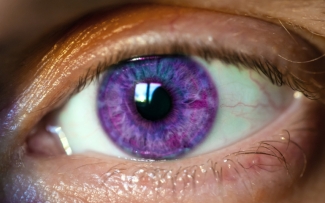Purple eyes
Purple or violet eyes often draw attention because of their distinct and uncommon appearance. While some consider them to be a shade of blue, purple eyes are a genuine and naturally occurring eye colour.
Read on to learn how rare purple eyes are, what causes them to occur, and what health conditions are associated with them. We will also discuss how makeup and contact lenses can create the appearance of purple eyes, and address myths about this eye colour.
How rare is purple eye colour?
Purple-coloured eyes are extremely rare. Although they have appeared throughout history, they remain uncommon. People with violet eyes make up less than 1% of the global population.
What causes purple eyes?
Eye colour is determined by two key factors: melanin and genetics. Typically, the more melanin (or pigment) in the iris, the darker the eye colour. Less melanin is associated with lighter eye colours.
Humans with purple eyes have less melanin, which causes light entering their eyes to scatter. As a result, more violet light is reflected out, giving the eyes their purple appearance.
Eye colour genetics are a bit more complicated. Scientists now believe that dozens of genes can influence the amount of melanin you produce and, in turn, the colour of your eyes.
Additionally, certain medical conditions can cause a person’s eye colour to change and make them appear more violet in hue.
Purple-eye diseases
If you aren’t born with purple or violet eyes, it’s possible for your eyes to change colour as the result of certain conditions.
Some conditions that can affect eye colour include:
- Uveitis – Inflammation inside the eye
- Fuchs’ heterochromic iridocyclitis (FHI) – Inflammation and pigment loss associated with higher risk for glaucoma and cataract
- Horner's syndrome – Nerve damage affecting the eye and face on only one side of the body
If you experience any sudden or dramatic change in eye colour, contact your eye care professional immediately. Such changes, especially when accompanied by other symptoms like pain, light sensitivity, or vision changes, can be a sign of an underlying health issue.
Purple eyes and albinism
A common cause of violet eyes is albinism, a genetic condition where the body produces little or no melanin. In individuals with ocular albinism, the absence of melanin in the iris allows blood vessels to be more visible through the eye tissue. The combination of visible blood vessels and light scattering and reflecting as it enters the eyes can result in a purple appearance.
Key symptoms of ocular albinism include:
- Reduced visual acuity (sharpness)
- Sensitivity to bright light (photophobia)
- Rapid, involuntary eye movements (nystagmus)
- Increased risk of vision problems such as strabismus (eye misalignment or crossed eyes)
Melanin helps protect the eyes by absorbing the sun’s harmful ultraviolet rays. Without this protective pigmentation, people with albinism may be more vulnerable to UV damage and may experience more eye and vision problems than others.
Alexandria’s Genesis: Fact or fiction?
A persistent myth regarding purple-coloured eyes is a fictional genetic mutation or condition called Alexandria’s Genesis. According to legend, if a baby is born with this “perfect human” mutation, their eyes will turn purple at six months old.
The change in eye colour is a sign that the child will also possess other extraordinary traits, such as perfect health and delayed ageing. However, there is no scientific evidence to support the existence of such a condition.
The story of Alexandria’s Genesis is purely fictional and has been debunked by medical experts. Violet eyes may be uncommon, but nothing about them is supernatural.
Makeup and contact lenses
For most people, achieving the look of purple eyes is a cosmetic choice Fortunately, coloured contact lenses provide a temporary way for you to experiment with violet and other rare eye colours. They are widely available and commonly used by celebrities to change up their look.
In addition, makeup can enhance or simulate the look of violet eyes. Eyeshadows in purples and lilacs, paired with eyeliner and mascara, can draw attention to light-coloured eyes, enhancing any low-lying blue or grey undertones to create a subtle violet effect.
Celebrities with purple eyes
One of the most famous people associated with violet eyes was a celebrated actress from Hollywood’s Golden Age. Elizabeth Taylor’s purple eye colour made her iconic appearance all the more striking.
Though her eyes were often described as violet, experts believe Taylor’s eye colour was actually a deep blue with unique undertones that created a more purple appearance. The violet hue was likely enhanced (and accentuated) by environmental factors like bright studio lighting, professionally applied makeup, and a fabulous wardrobe.
Embracing the uniqueness of purple eyes
While natural purple eyes are rare, they can be achieved intentionally through the art of makeup and cosmetic contact lenses. Myths and legends may enhance their mystique, but the beauty of this rare eye colour lies in its uniqueness and individuality.
If you’re fascinated by rare eye colours, explore coloured contact lenses to experiment with violet or another unique hue. Just remember to prioritise your eye health first. Book an eye test to get an updated contact lens prescription and ask your optician if any cosmetic lenses will work for you.


